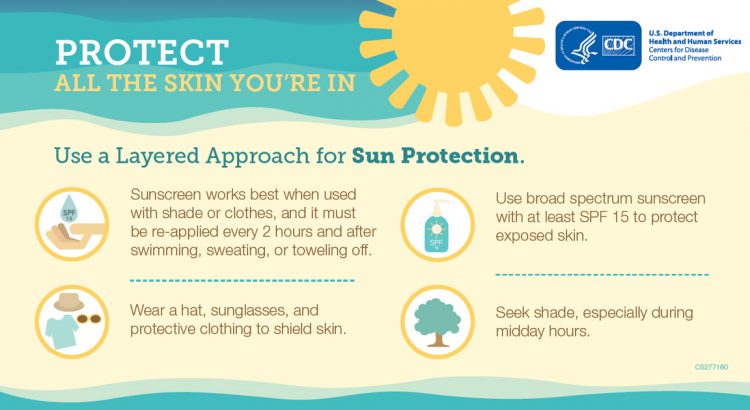by Liz Stovall, Division Manager- Fitness and Wellness
Some people think about sun protection only when they spend a day at the lake, beach or pool. But, sun exposure adds up day after day, and it happens every time a person is in the sun. While brief exposures to sunlight help the body make Vitamin D to stay healthy, too much sunlight can cause cancer. That’s why sun-safe habits should begin in childhood and last a lifetime. Everyone’s skin and eyes can be affected by the sun and other forms of ultraviolet (UV) rays. Tanning occurs when UV radiation is absorbed through the skin. It causes an increase in the activity and number of melanocytes, the cells that make the pigment melanin. Melanin gives the skin its color. It also helps to block out damaging UV rays up to a point. While sunburns are thought to increase a person’s risk of skin cancer, UV exposure, even without a sunburn, can raise skin cancer risk.
Take these steps to stay sun-safe:
- Slip on a shirt and sunglasses: When out in the sun, wear clothes that protect the skin as much as possible. Clothes provide different levels of UV protection. Long-sleeved shirts, long pants, or long skirts cover the most skin and are the most protective. Many companies now make clothing that is light-weight, comfortable, and protects against UV exposure, even when wet. These sun-protective clothes may have a label listing the UV protection factor (UPF). The higher the UPF, the higher the protection from UV rays. UV-blocking sunglasses are also important for protecting the delicate skin around the eyes. The ideal sunglasses should block 99% to 100% of UVA and UVB rays. Before you buy, check the label to make sure it reads “UV absorption up to 400nm.” Sunglasses labeled “cosmetic” block only 70% of UV rays. If there is no label, don’t assume the sunglasses provide any protection.
- Slap on a hat: A hat with a two to three-inch brim all around is ideal. It protects areas often exposed to the sun such as the neck, ears, eyes, forehead, nose and scalp. A shade cap (which looks like a baseball cap with about seven inches of fabric draping down the sides and back) is also good. A baseball cap protects the front and top of the head but not the back of the neck or ears, where skin cancers often grow. Straw hats are not recommended unless they are tightly woven.
- Slop on the sunscreen: Apply sunscreen to the skin to help protect against the sun’s UV rays. Sunscreens come in many forms – lotions, creams, ointments, gels, wipes, and lip balms, to name a few. Choose a broad-spectrum sunscreen with a sun protection factor (SPF) of 30 or higher (broad spectrum means that the sunscreen blocks both UVA and UVB rays). Be sure to use enough and re-apply every couple of hours while you’re in the sun. Best practice is to use sunscreen as one part of your skin care routine, especially if staying in the shade and wearing protective clothing aren’t available as your first options. Some cosmetics such as moisturizers, lipsticks, and foundations, are considered sunscreen products. Be sure to always check the label first.
Additional sun-smart ideas:
- Protect children from the sun: Since they tend to spend more time outdoors, children need special attention as they can burn more easily than adults. Parents and caretakers should be sure their children wear clothes, hats, sunglasses, and sunscreen to protect from harmful UV rays.
- Limit midday sun exposure: UV rays are most intense during the middle of the day, usually between the hours of 10:00 a.m. and 4:00 p.m. To check the sun’s intensity, use the shadow test. If a person’s shadow is shorter than they are, the sun’s rays are the strongest. If possible stay out of the sun during this time of day.
- Avoid tanning beds and sun lamps: Tanning beds and sun lamps give out both UVA and UVB rays. These rays can cause serious long-term skin damage and can lead to skin cancer.
